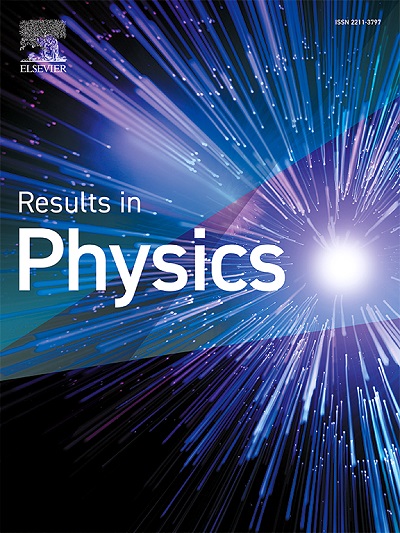基于响应面法Box-Behnken设计的三元混合纳米流体收敛/发散通道热分析
IF 4.6
2区 物理与天体物理
Q2 MATERIALS SCIENCE, MULTIDISCIPLINARY
引用次数: 0
摘要
汇聚/发散通道代表了热管理系统的关键进步,通过几何优化的流动路径提供增强的传热能力。本文研究了UO2-ZnO-Fe3O4/ eg -水三元混合纳米流体在旋转收敛/发散通道中的热学和流体动力学特性,并结合磁流体动力学和辐射效应,研究了现代热管理系统中提高传热效率的关键领域。采用Runge-Kutta-Fehlberg方法结合Box-Behnken设计方法,分析了关键参数对流动行为和传热性能的影响。数值模拟结果表明,纳米颗粒体积分数从0.01增加到0.06,努塞尔数提高27.3%,而磁性参数的增加使摩擦系数降低41.2%。雷诺数与努塞尔数呈正相关(R2 = 0.978)。最大传热(ν= 33.4859)实现:α= 1°,Re = 40,φ= 3%,哈= 50,Rd = 1, Kn = 0.04, = 0.5, Ro = 50,ε= 0,λ= 0.5而最小流动阻力(Cf = -2.60454)发生在:α= 3°,Re = 60,φ= 6%,Rd = 1公顷= 25日Kn = 0 = 0.5, Ro = 50,ε= 0.2,λ= 0.5。在相同流动条件下,收敛型通道(α = -3°)的摩擦系数比发散型通道(α = 5°)的摩擦系数高28.3%。这项工作通过全面分析旋转、磁流体动力学、辐射和通道几何对三元混合纳米流体性能的协同效应,使该领域超越了以往的研究,为在电子冷却、热交换器和工业加工应用中设计更高效的热系统提供了重要的见解。本文章由计算机程序翻译,如有差异,请以英文原文为准。
Thermal analysis of ternary hybrid nanofluid flow in convergent/divergent channel using Box-Behnken design of response surface methodology
Convergent/divergent channels represent a critical advancement in thermal management systems, offering enhanced heat transfer capabilities through geometrically optimized flow paths. This study investigates the thermal and hydrodynamic characteristics of UO2-ZnO-Fe3O4/EG-water ternary hybrid nanofluid in rotating convergent/divergent channels with magnetohydrodynamic and radiation effects, a critical area for enhancing heat transfer efficiency in modern thermal management systems. Employing the Runge-Kutta-Fehlberg method coupled with a Box-Behnken design approach, we analyzed how key parameters affect flow behavior and heat transfer performance. The numerical simulations reveal that increasing the nanoparticle volume fraction from 0.01 to 0.06 enhances the Nusselt number by 27.3 %, while an increase in the magnetic parameter reduces the friction coefficient by 41.2 %. The Reynolds number demonstrates a strong positive correlation with the Nusselt number (R2 = 0.978). Maximum heat transfer (Nu = 33.4859) achieved at: α = 1°, Re = 40, φ = 3 %, Ha = 50, Rd = 1, Kn = 0.04, De = 0.5, Ro = 50, ε = 0, λ = 0.5 whereas a minimum flow resistance (Cf = -2.60454) occurred at: α = -3°, Re = 60, φ = 6 %, Ha = 25, Rd = 1, Kn = 0, De = 0.5, Ro = 50, ε = 0.2, λ = 0.5. For the convergent channel configuration (α = -3°), the friction coefficient was 28.3 % higher than in the divergent channel (α = 5°) under identical flow conditions. This work advances the field beyond previous studies by comprehensively analyzing the synergistic effects of rotation, magnetohydrodynamic, radiation, and channel geometry on the performance of ternary hybrid nanofluids, providing crucial insights for designing more efficient thermal systems in electronics cooling, heat exchangers, and industrial processing applications.
求助全文
通过发布文献求助,成功后即可免费获取论文全文。
去求助
来源期刊

Results in Physics
MATERIALS SCIENCE, MULTIDISCIPLINARYPHYSIC-PHYSICS, MULTIDISCIPLINARY
CiteScore
8.70
自引率
9.40%
发文量
754
审稿时长
50 days
期刊介绍:
Results in Physics is an open access journal offering authors the opportunity to publish in all fundamental and interdisciplinary areas of physics, materials science, and applied physics. Papers of a theoretical, computational, and experimental nature are all welcome. Results in Physics accepts papers that are scientifically sound, technically correct and provide valuable new knowledge to the physics community. Topics such as three-dimensional flow and magnetohydrodynamics are not within the scope of Results in Physics.
Results in Physics welcomes three types of papers:
1. Full research papers
2. Microarticles: very short papers, no longer than two pages. They may consist of a single, but well-described piece of information, such as:
- Data and/or a plot plus a description
- Description of a new method or instrumentation
- Negative results
- Concept or design study
3. Letters to the Editor: Letters discussing a recent article published in Results in Physics are welcome. These are objective, constructive, or educational critiques of papers published in Results in Physics. Accepted letters will be sent to the author of the original paper for a response. Each letter and response is published together. Letters should be received within 8 weeks of the article''s publication. They should not exceed 750 words of text and 10 references.
 求助内容:
求助内容: 应助结果提醒方式:
应助结果提醒方式:


